From a privileged perspective for an evocative view of all of Florence, Villa Bardini reopened its doors to visitors after two years of closure due to the pandemic with a major exhibition dedicated to one of its most illustrious who knew how to maintain a relationship with his origins but who, driven by an innovative and modern spirit, had the strength above all to look beyond Italy to confront the most fashionable trends in Europe and the major artists who best represented thatwave of renewal that invested and inspired all European art of that time. An exhibition that Florence is dedicating to Galileo Chini (Florence, 1873 - 1956), a tribute that the Tuscan capital wanted to pay to the Florentine painter, illustrator and ceramist who was at the time one of the best-known Italian artists in Europe, looked up to by great interpreters of twentieth-century art such as Umberto Boccioni, and who had relationships with the major European artists of his time.
Curated by Fabio Benzi and open to visitors until April 25, 2022, the exhibition titled Galileo Chini and European Symbolism, from which the open view of the international panorama is evinced as a characteristic trait of the artist who was among the leading European exponents of Art Nouveau modernism and Symbolism (an open view of the world like the one the visitor makes on the city of Florence if he looks out from the Villa’s Belvedere), focuses on the first two decades of his career, from 1895 to 1914, that is, from his early maturity to the threshold of World War I, in which Chini adhered to Symbolism and the modernist impulses ofArt Nouveau. Years characterized by an enormous cultural vitality involving French and Central European Symbolism, the Secessions, and Art Nouveau taste, thanks also to relationships and cultural exchanges with the likes of, to name a few, Auguste Rodin, Max Klinger, Ferdinand Hodler, Gustav Klimt, William de Morgan, Odilon Redon, Gaetano Previati, and Giovanni Segantini. Along the exhibition route, in fact, works by the latter are placed in dialogue with Chinian masterpieces: an example of this is the room displaying the Portrait of Rodin made by Chini in 1901 with underneath the plaster Danaide that Rodin donated to Galileo in the same year, the Portrait of Chini’s wife with theSelf-portrait and the Portrait of Fernand Khnopff’s sister made between 1898 and 1900, Galileo Chini’s illustrations of the Alinari Divine Comedy compared with the engravings by Max Klinger.
Galileo Chini’s great versatility is manifested in the exhibition through works that belong to different languages and techniques: paintings, drawings and ceramics follow one another in the exhibition rooms in a very harmonious arrangement that offer the visitor continuous parallels, in line with the artist’s dominant thought that there was no division between major and minor arts. Following the modernist drive toward principles of expressive renewal, particularly of Art Nouveau and the Central European Secessions, Galileo Chini devoted himself along with painting to ceramics, of which he was the greatest innovator in Italy at that time, and to mural painting, preferring it to easel painting. Inspired by Walter Crane’s English theories of the applied arts Arts and crafts, Chini popularized the concept of industrially produced works of art: his ceramics produced in large numbers brought Art Nouveau taste into the homes of the Italian bourgeoisie, and his wall decorations spread to public settings. It was in 1917 that he issued the Manifesto Rinnovando rinnoviamoci, in which he proposed the abolition of the Academies of Fine Arts, promoters of an ’unacceptable distinction between the major arts, thus painting, sculpture, and architecture, and the minor arts, such as ceramics, for the establishment of “Industrial Art Schools apt to renew all forms of the applied arts.”
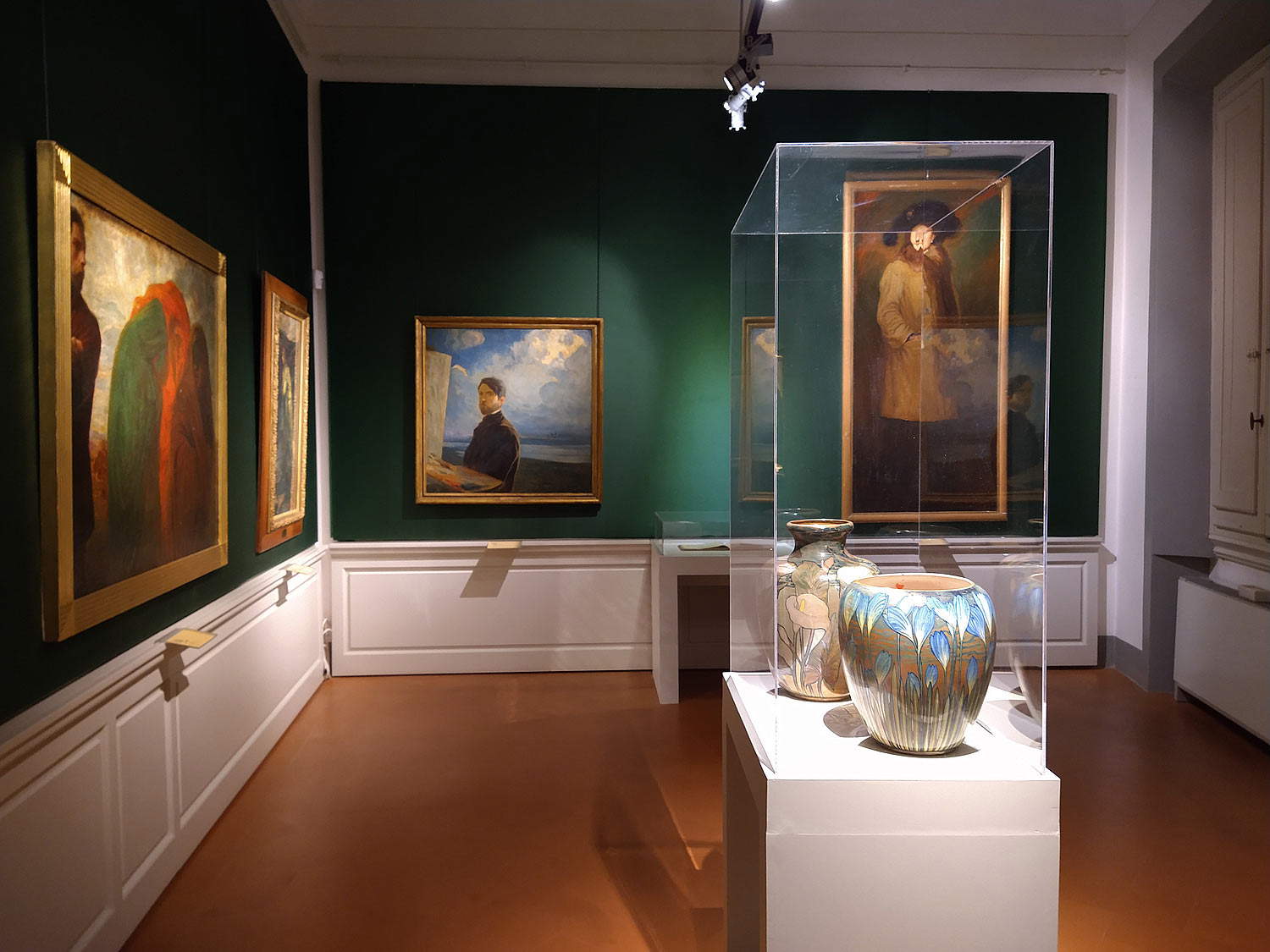
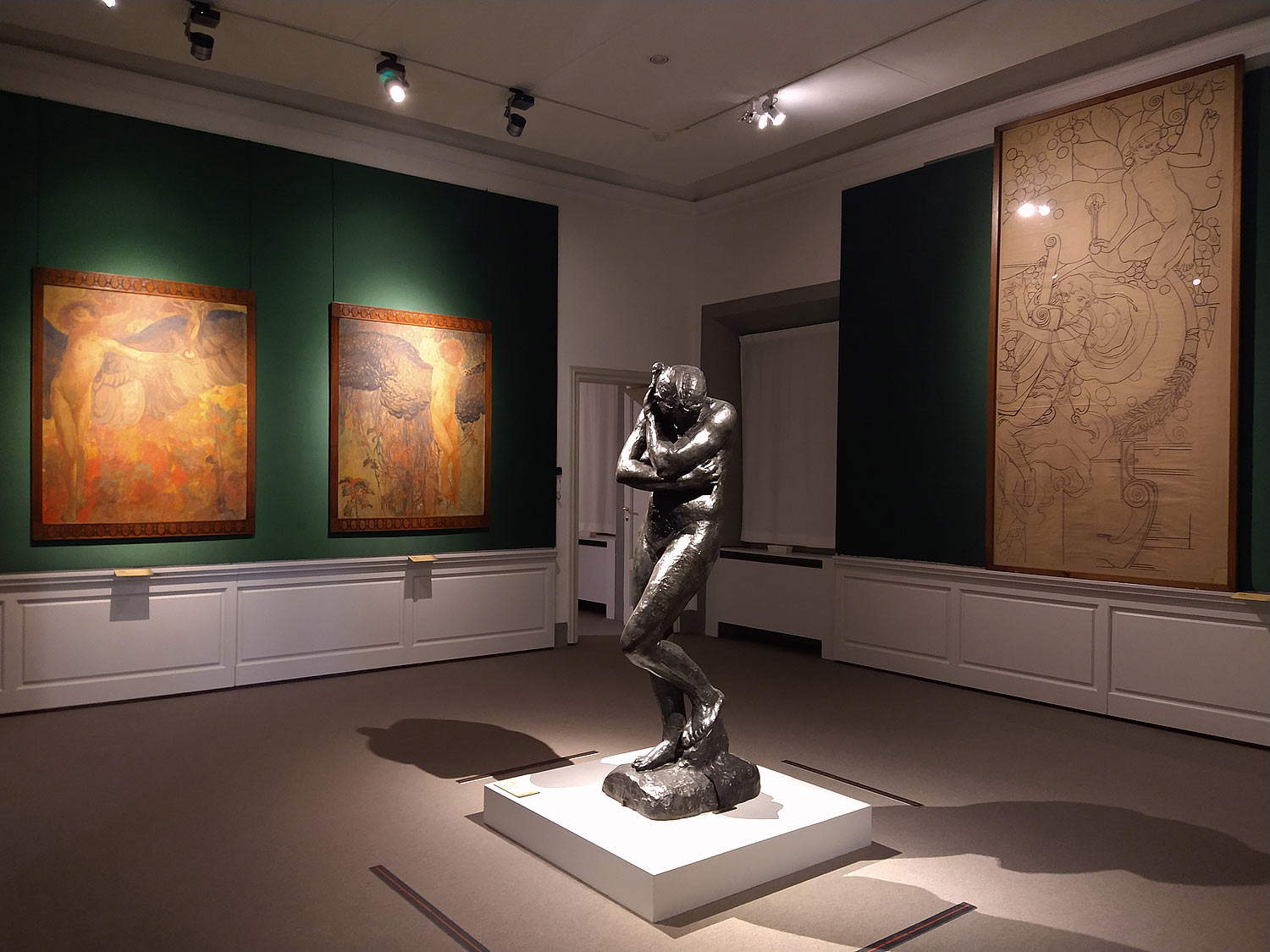
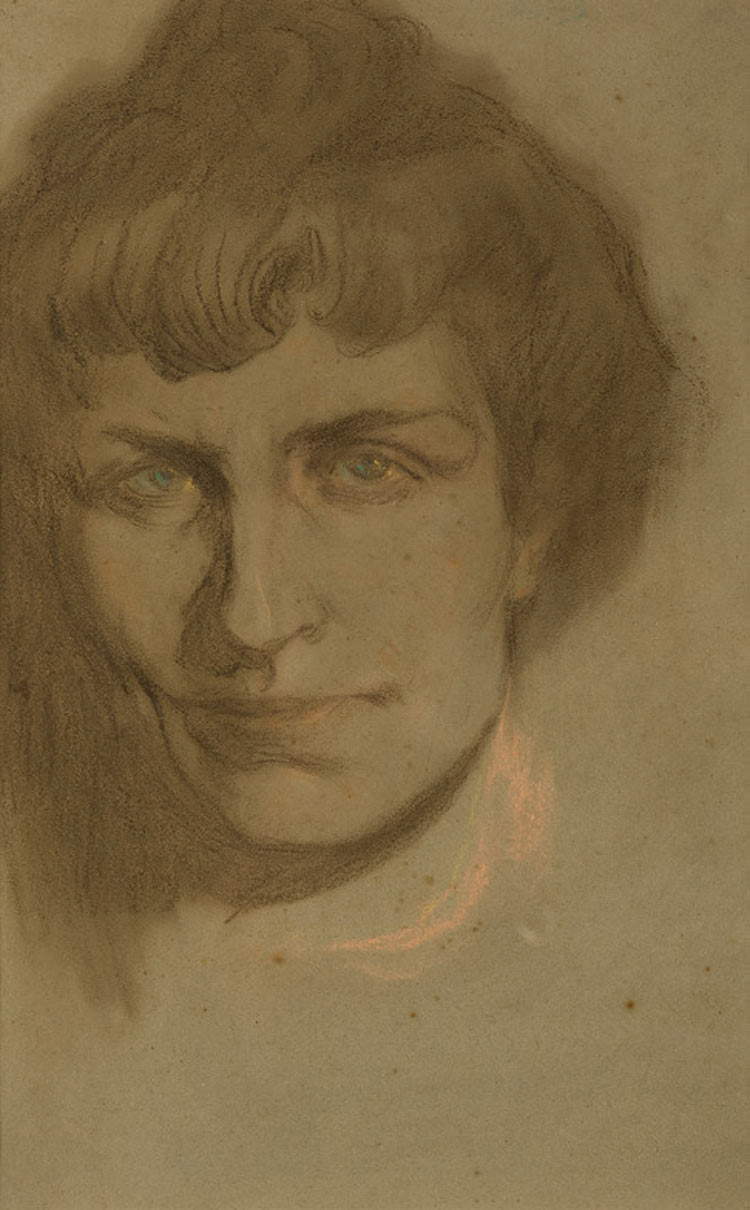
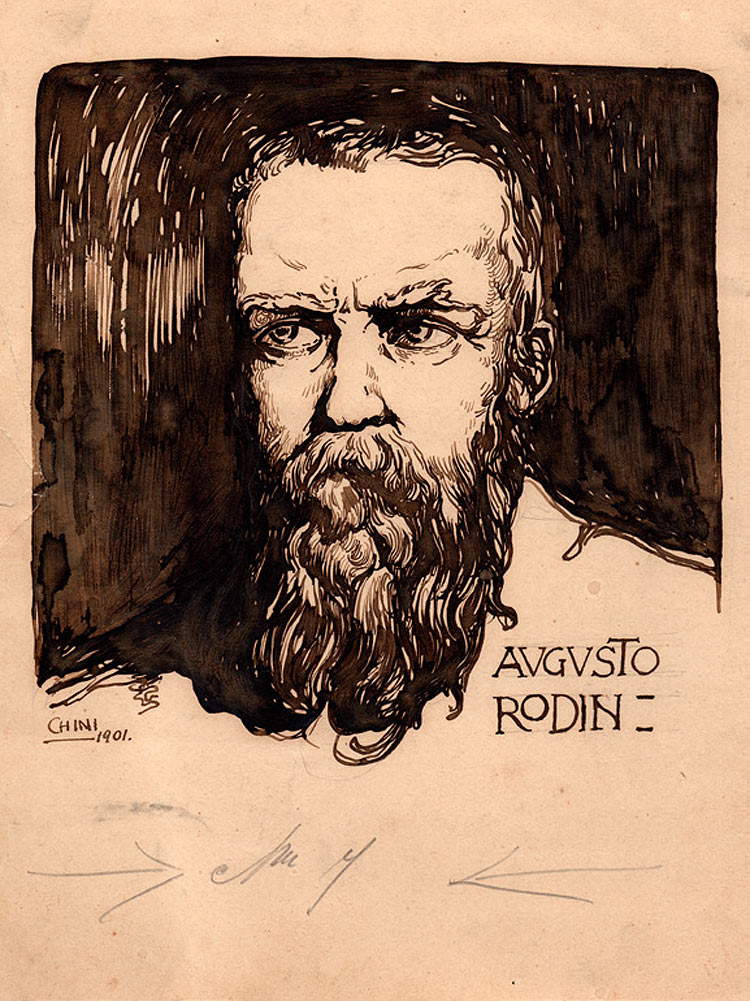
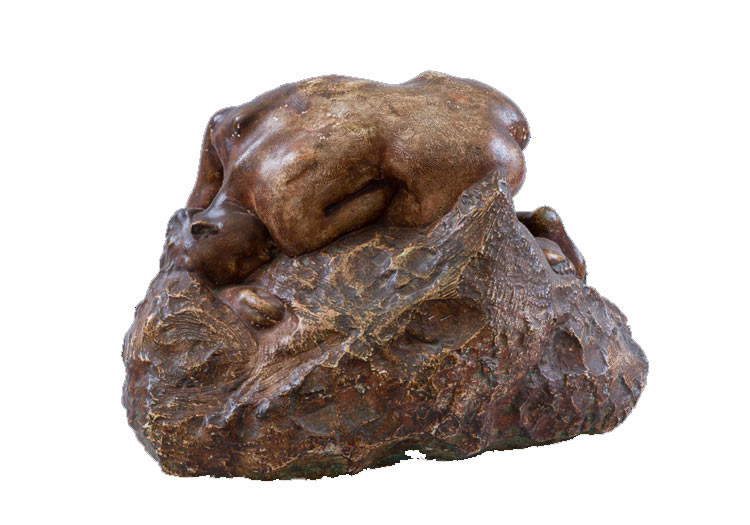

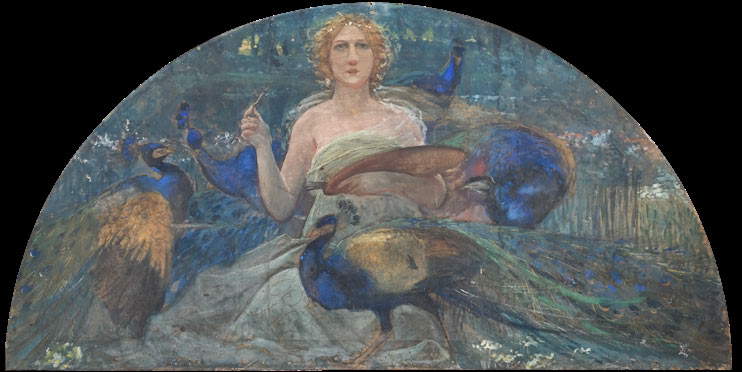
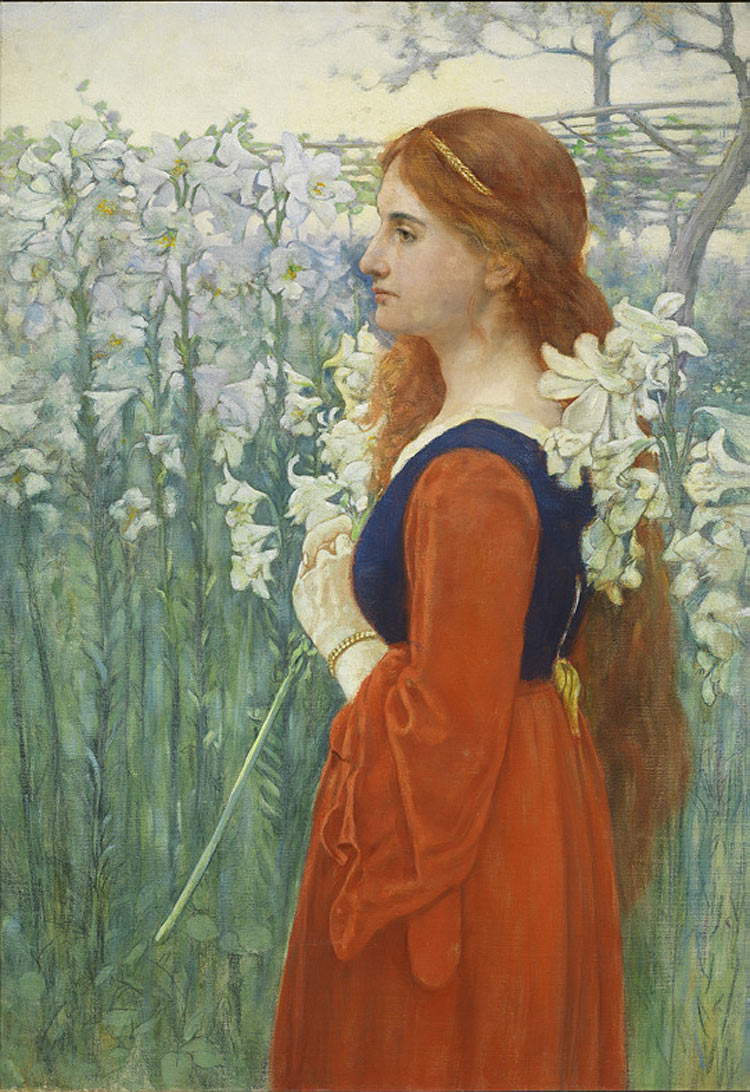
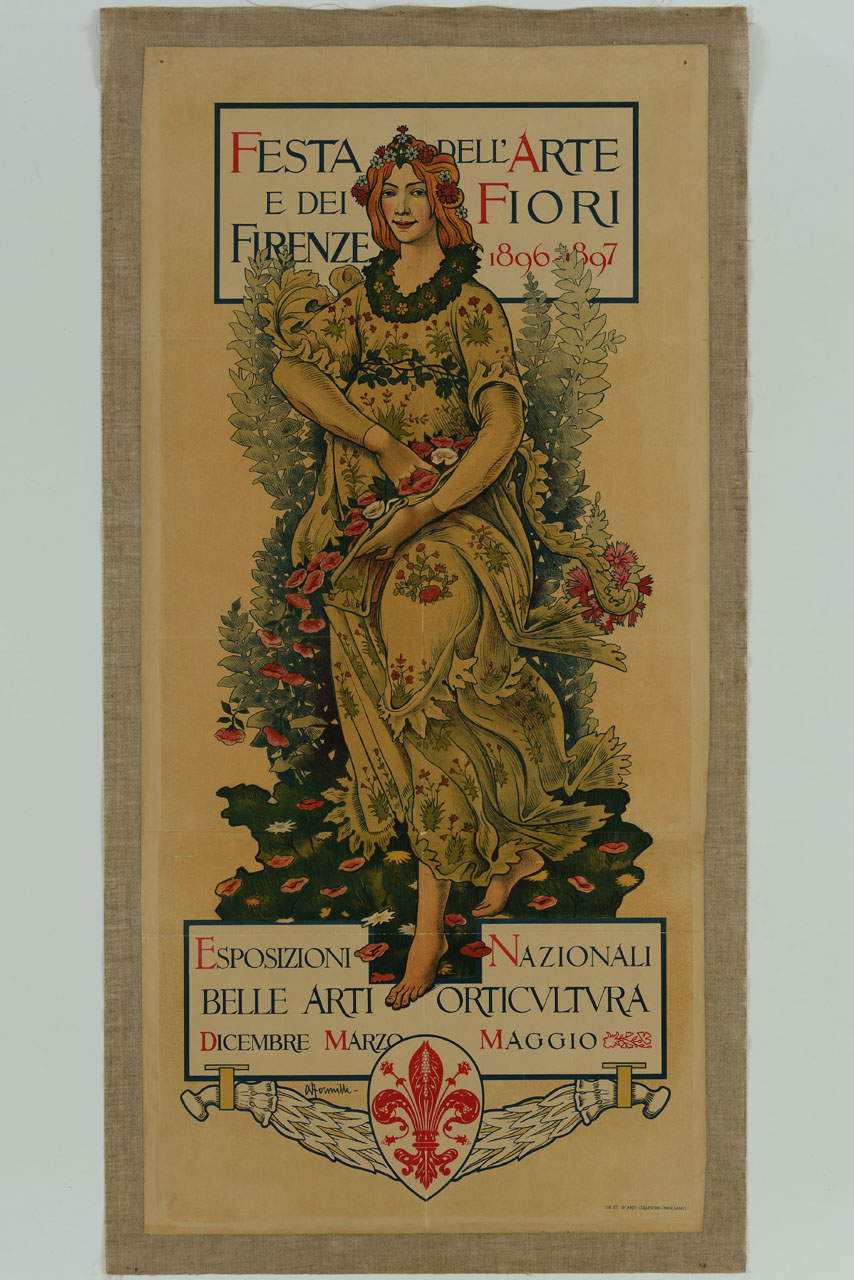
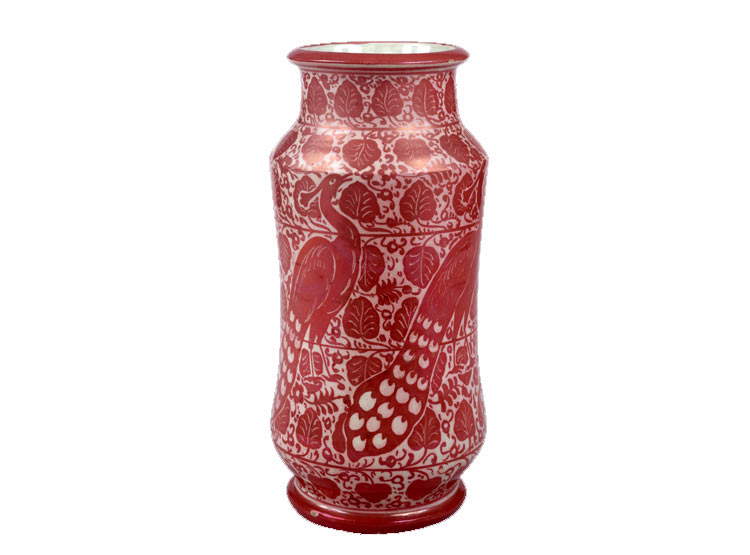
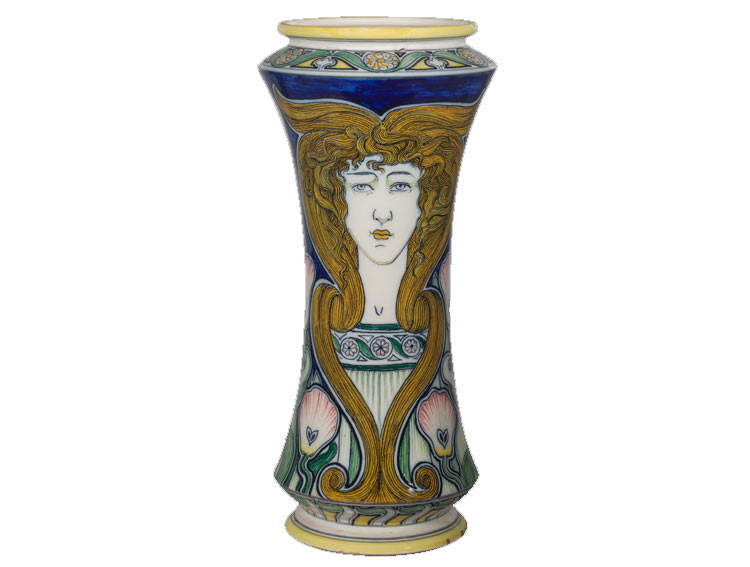
He himself founded in 1896 with Vittorio Giunti and Giovanni Montelatici the Arte della Ceramica, in Via del Ghirlandaio in Florence, with the aim of renewing Italian ceramics and making it worthy of belonging to the fine arts, reviving it in the manner of the ancients and taking it to the highest manifestations. His early production was inspired by Botticelli’s figures of women, mythological themes in the Pre-Raphaelite style, and phytomorphic and zoomorphic figures, with peacocks, fish, flowers, fruit and leaves. Chini also looked to William de Morgan, among the leading Arts and Crafts artists, who had worked for a long time in Florence at the Cantagalli firm: on display at Villa Bardini is an albarello (a traditional form of medieval and Renaissance majolica) with peacocks that the latter made in about 1890 for Cantagalli, a symbol of Art nouveau because a traditional form is reinvented with modern figures. Chini was inspired by these experiments when, on the traditional form of the albarello, he made a typically Art nouveau, Pre-Raphaelite design with women’s faces. Side by side in a display case are Chinian vases with mulieval faces from about 1898, a disc with a woman’s face from the same period, and sketches for vases with female profiles and flowers and with peacocks. The taste for Botticellian female figures, with an Art Nouveau-style Flora, in line with the Central European modernist art of Alphonse Mucha, is already revealed in the manifesto of Attilio Formilli ’s 1896 Florentine exhibition, Festa dell’Arte dei Fiori, which was Galileo’s first public debut: it was attended by young artists who wanted to break with the academic tradition prevailing in the city and who followed an ideal of renewal not only in painting but also in the applied arts, spread by modern magazines such as The Studio, the main vehicle for the spread of Pre-Raphaelism. Shortly, however, he will also turn his gaze to a Japanism of iridescent enamels and dripping monochromes, referring to Edo bronzes and porcelain, and to Nabis illustration that testifies to an acquaintance with Pierre Bonnard and the Revue Blanche (shown with lithographs).
As is the intent of the review and as the visitor perceives from the beginning of the exhibition itinerary, the first two decades of Chini’s production, more properly Symbolist, are a continuous dialogue with the most innovative trends in Europe at the time and with the most prominent exponents, always within a broad context, but still maintaining an unmistakable and independent personality. A willingness that is made evident right from the large pastel lunette depicting an Allegory of Painting datable to around 1895, with which the public at Villa Bardini is greeted after the initial ceramics they are confronted with as soon as they climb the stairs leading to the second floor of the building, as well as to the first of the two floors on which the Chinian exhibition is developed. In fact, the lunette already shows a detachment from the neo-Renaissance references of his master and decorator Augusto Burchi, at whom Galileo did his apprenticeship, and an approach to Divisionist technique with reference to the example of Giovanni Segantini (with the addition of the already present peacocks that would become one of the most frequent subjects in Chini’s art, especially the ceramic one, as well as very widespread in Art nouveau). Slightly later, however, is the Portrait of Sister Pia (1896-1897), where there is a clear reference to Pre-Raphaelism, mentioned earlier, through a young maiden in medieval dress immersed in a garden full of lilies. Pointillist experience, developed with his friend Plinio Nomellini, combines with a dense and fast French-derived brushstroke to create backgrounds rich in glow, such as those in two paintings in the exhibition, namely the more reddish 1899-1900 Portrait of Elvira and the 1901Self-Portrait, in which Chini portrays himself with palette in hand on the beach and a sky of clouds from which glimmers of sunlight can be glimpsed. It is a foggy sky with brown-gray hues and at the same time with luminous gleams that instead depicted in The Factory of 1901, an allegory of the Factory holding a lily, symbol of Florence, in one hand and holding a statuette with a winged victory with the other outstretched forward, indicating the success of the Art of Ceramics that moved from small rooms to its new and larger premises in Fontebuoni. On the other hand, The Kiss of the Mermaid, a masterpiece by Max Klinger, stands in direct comparison with Galileo Chini’s The Red Sea at Sunset: in both, in fact, the waves of the sea reflect the light and colors of the sky.
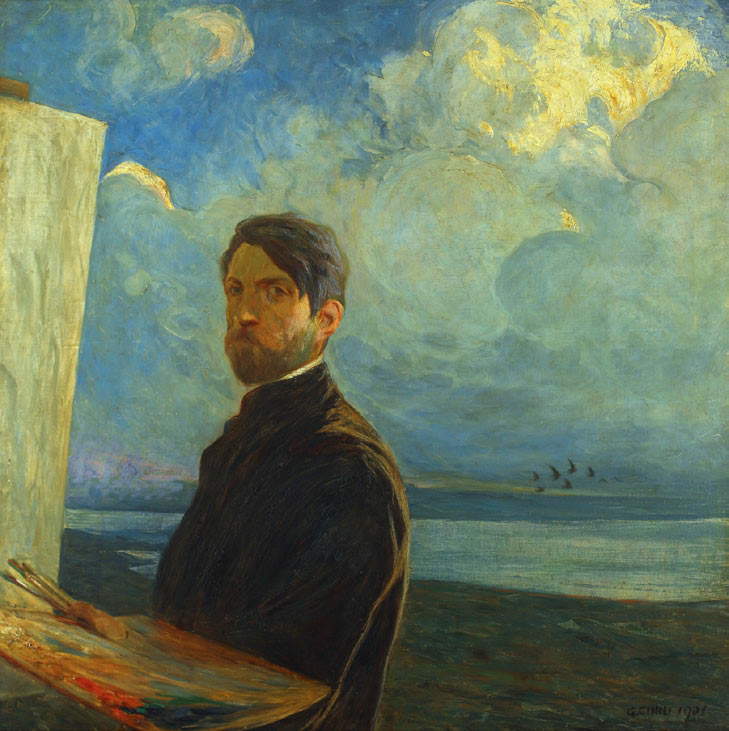

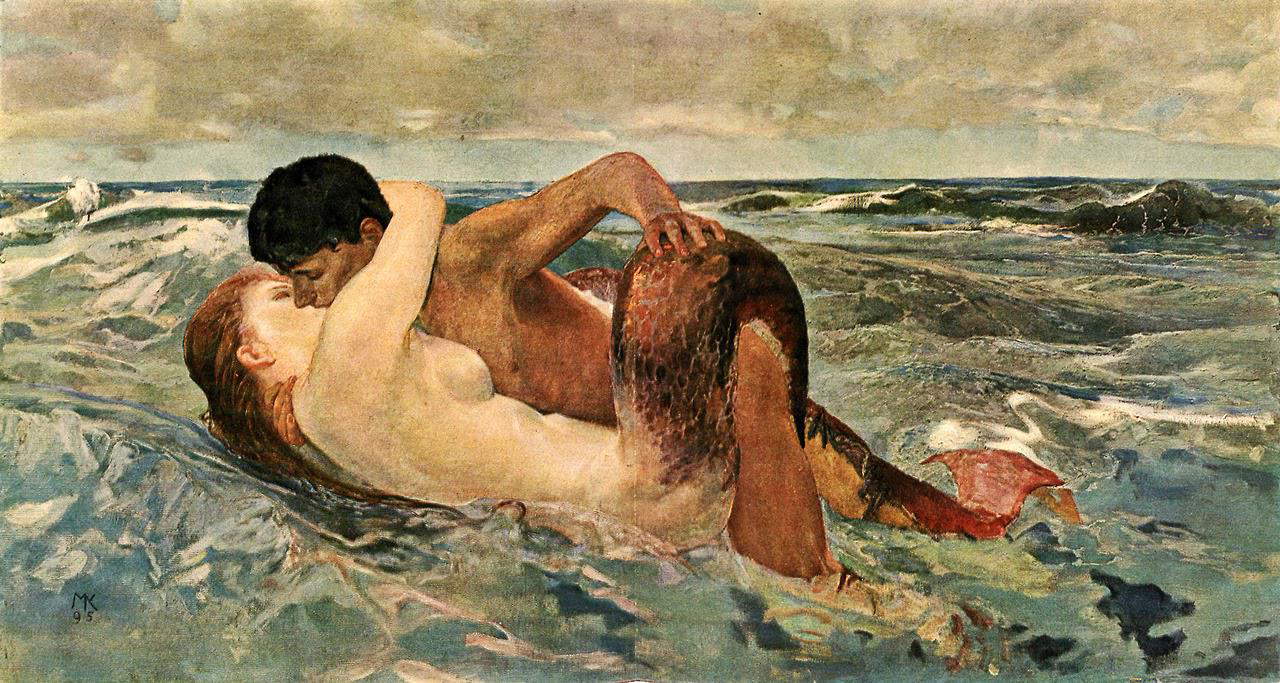
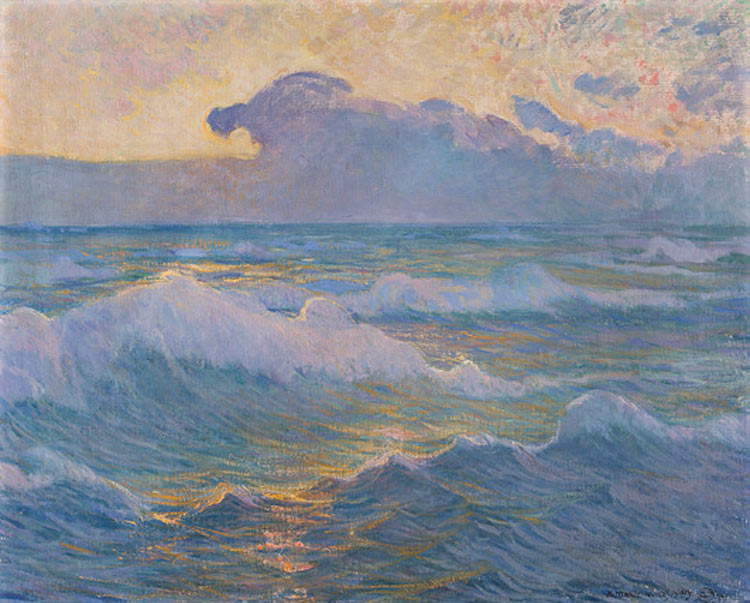
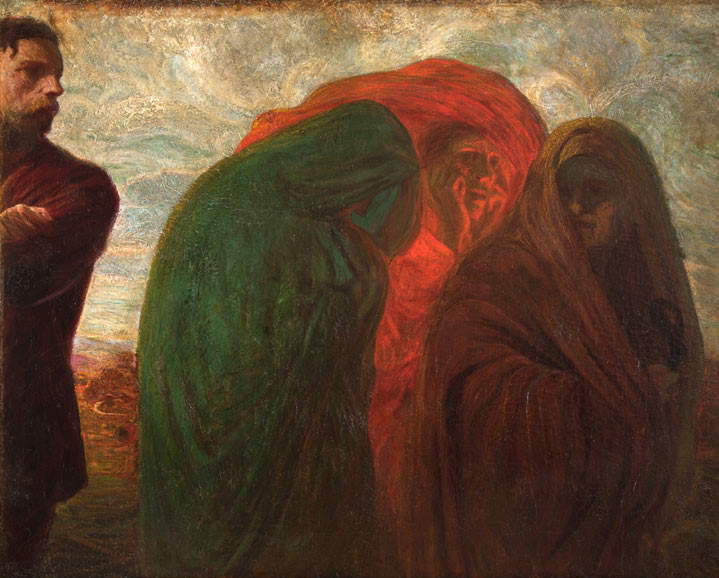

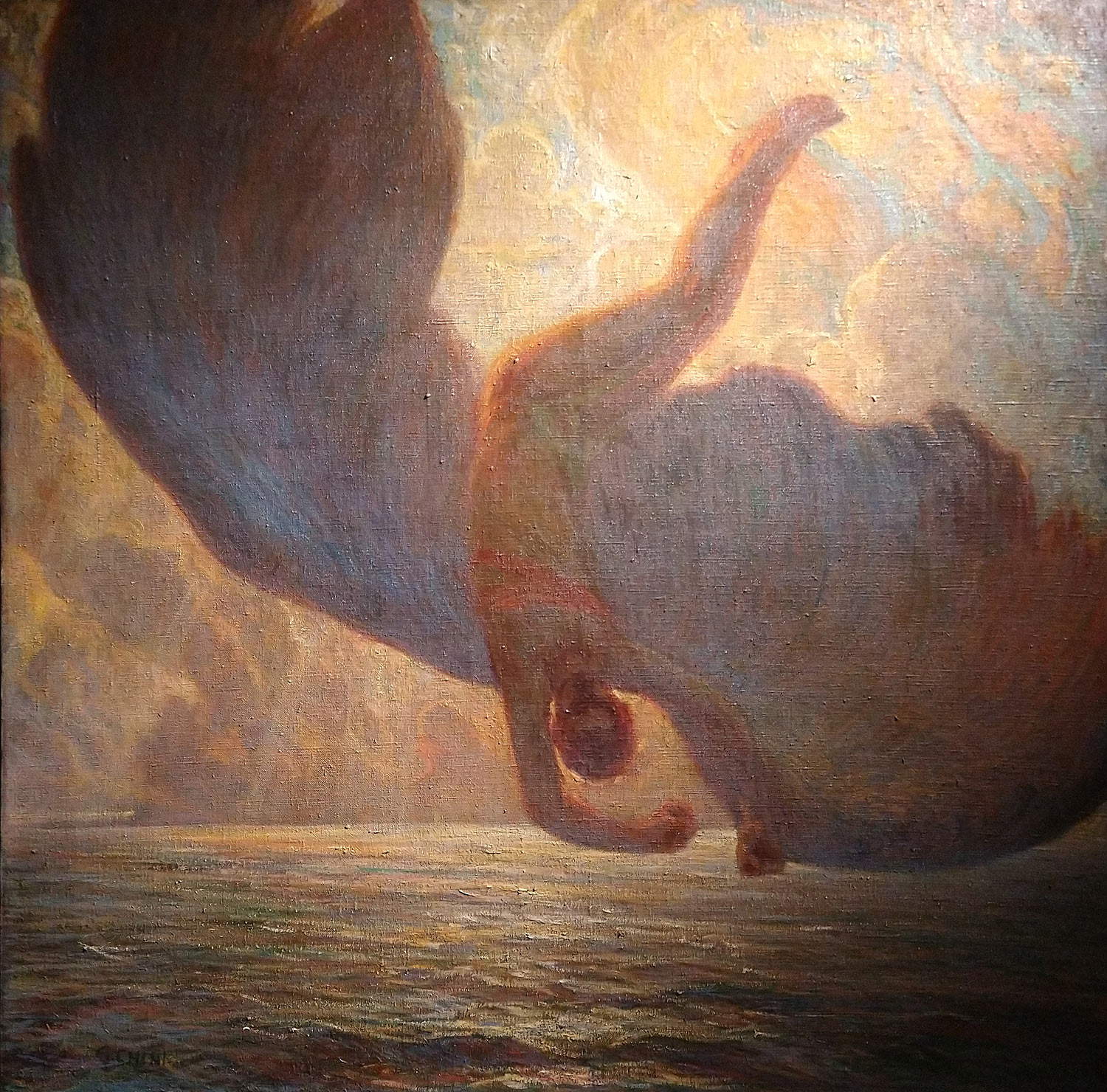

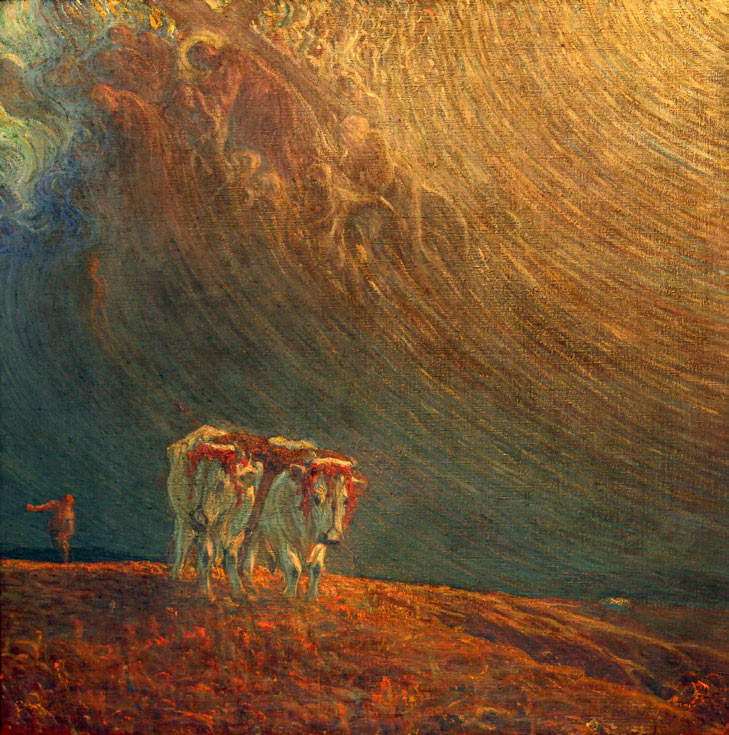

The first exhibition in Italy that brought together those young artists eager for renewal in opposition to the official and academic exhibitions was the one at Palazzo Corsini in 1904, organized by Chini himself, Giovanni Papini and Ludovico Tommasi: during the opening speech, the latter even gave “monkeys” to the academics of the Society of Fine Arts. To Palazzo Corsini Chini brought some paintings that are on display at the Villa Bardini exhibition, such as the aforementioned Self-Portrait, The Equals, and TheFrauds. The Equals harkens back to the macabre of Franz von Stuck and Arnold Böcklin with these dark-faced figures almost in procession, while in The Frauds three female figures wrapped in their cloaks are depicted trying to hide their faces by moving away from the standing man, a self-portrait of the painter, emphasizing how the painter in his search for truth casts out frauds, that is, stratagems to gain fame. In this sense, the painting becomes almost a manifesto of the Palazzo Corsini exhibition that aims to promote authentic, true and symbolic art against academic falsehoods.
A milestone in Galileo Chini’s career was the decoration of the Sala del Sogno at the 1907 Biennial, conceived together with Nomellini, where he executed a large fresco with references to Segantini and Previateschi, with putti very similar to those he created three years earlier in the ballroom of the Grand Hotel La Pace in Montecatini, the latter considered among the artist’s first mural masterpieces. The influence of Gaetano Previati and Giovanni Segantini, among the greatest exponents of pointillism, is thus very much felt on these occasions. In the exhibition, the Room of the Dream is recalled by the panel with Putti with ribbons and garlands, the St. John Taken Off that recalls Gustave Moureau, and the Previati-inspired Giogo and Icarus in which the golden and silvery glows in the sky and in the water create a highly evocative atmosphere by acting as a backdrop to the fall of the human figure depicted on the canvas a moment before it plunges into the sea. In the same recess where theIcarus and the Giogo are placed, the visitor is fascinated by the large panel of The Classical Spring, which Chini presented for the Sala Meštrovi? of the 1914 Biennial: here the artist wanted to recall the Viennese Secession, first and foremost Gustav Klimt, through panels defined precisely as Klimtian by critics, to express Spring, the generating force of nature and therefore of art. An exhibition section, therefore, that intends to show the contribution that Chini made to the Venice Biennials with those two wonderful rooms that made him further famous for the great interpretative force of the renewal of the last years.

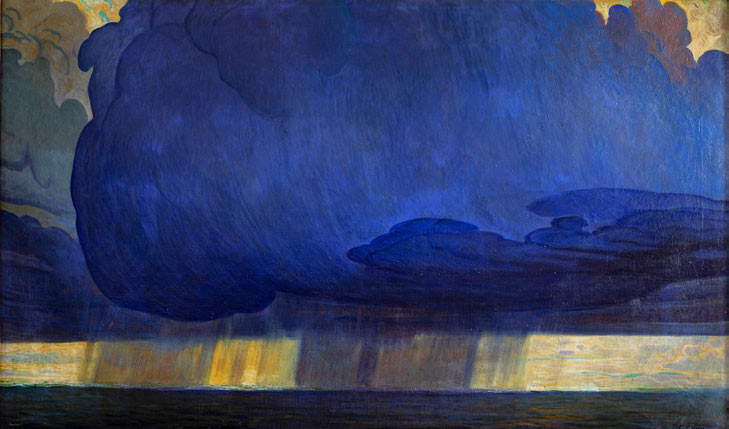
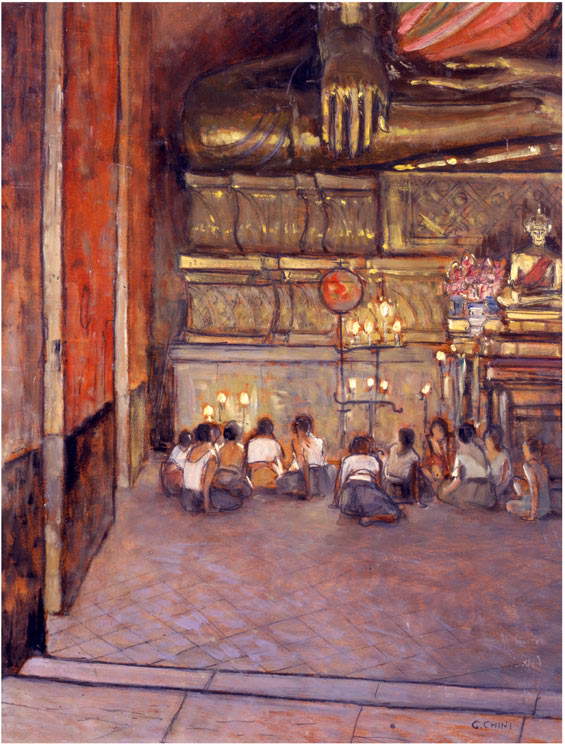

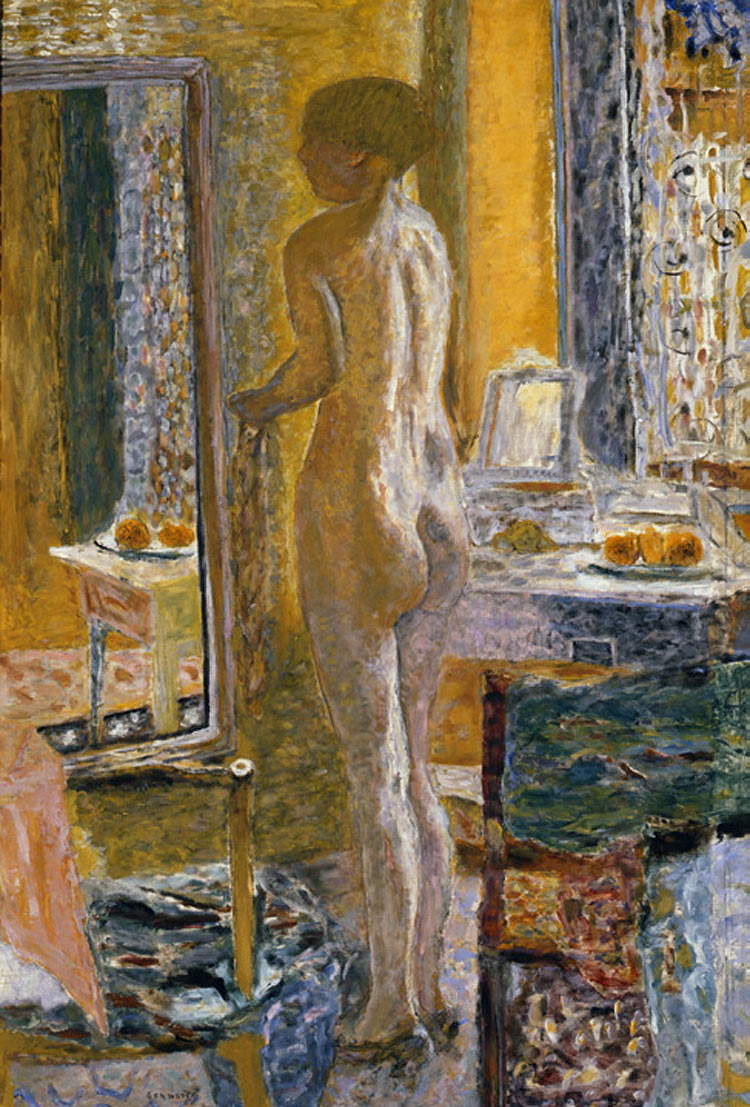
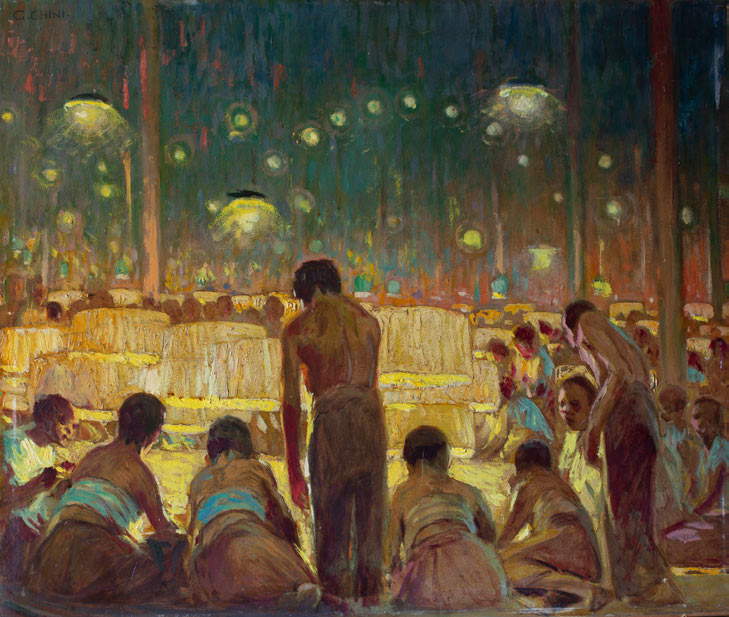
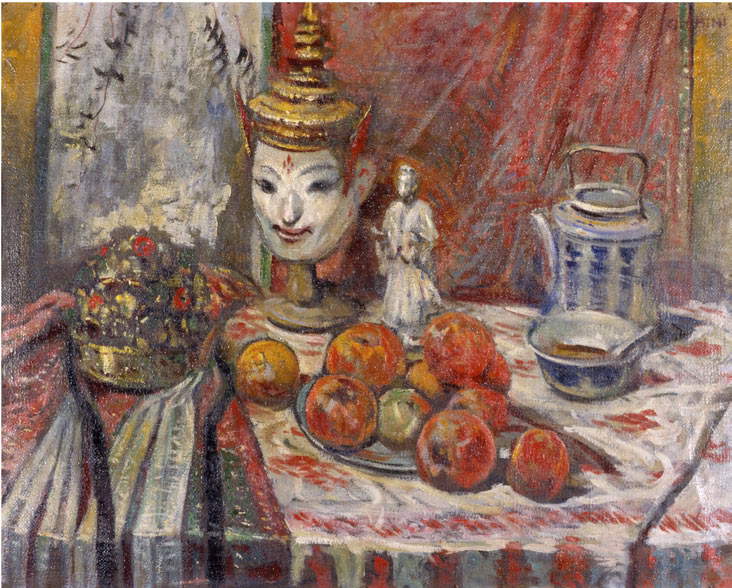
The second floor of the exhibition leads the public to a large room where Chini’s Siamese sojourn is recounted: in fact, the painter embarked in Genoa in June 1911 on the steamer Princess Alice bound for Bangkok. King Rama V commissioned the artist to fresco the Throne Room (a study for the palace decorations with Siamese Costumes is on display), influenced by the 1907 Dream Room he saw on his last trip to Europe. During the voyage by ship, a mass of dark clouds crossed by the sun showed itself before his eyes, which found its transposition on canvas in Typhoon (juxtaposed here with Vallotton’s The Great Cloud ), a landscape of strong impact that also provokes a powerful emotion in the observer; a feeling born of a natural phenomenon that substitutes an esoteric and theosophical symbolism. We then look at masterpieces such as The Grand Chinese’s Bisca in Bangkok, In the Wat and My Friend the Mandarin, images of a distant world rich in golden glow and imbued with strong emotional pathos that bear similarities to the interior paintings of Bonnard and other ex-Nabis painters: an example is Pierre Bonnard ’s Nude in the Mirror of 1931, exhibited in the same room.
Finally, the exhibition closes with a small focus on the last Chinian period in which his vision follows a more Bonnardian sentiment: both coming from Symbolist experiences, they then land inpsychological impressionism, more intimate and introspective, with a preference for interiors characterized by blurred figures and hues between red, orange and purple. Emblematic is the Still Life with Siamese Mask that Galileo Chini completed in 1939, in which the painter expresses a sense of nostalgia through that oriental souvenir he had brought with him from Siam.
Through more than two hundred works, the exhibition at Villa Bardini traces the first two decades of the career of the Florentine artist who was able to make his mark and be widely recognized in Europe thanks to his innovative and countercultural instincts. The visitor has the opportunity, thanks to the continuous cross-references and comparisons, to understand the wide-ranging context within which Chini’s art moved from the last decade of the nineteenth century until the mid-1910s, that is, his Symbolist period that would later evolve into an Impressionism charged with interior and psychological values.
All in a harmonious and pleasing arrangement, thanks to the alternation of paintings, illustrations and ceramics that confirm the equal dignity between the so-called major and minor arts, as in the artist’s principles. The rich catalog offers contributions by various scholars, as well as the curator, on the aspects that characterized those two decades, such as environmental decoration, international exhibitions and graphic work within the international Symbolist experience; there are also works not shown in the exhibition but useful for further comparisons and parallels. The first exhibition tribute to Galileo Chini in his hometown has also been overdue and now deserves all the attention it can get.
Warning: the translation into English of the original Italian article was created using automatic tools. We undertake to review all articles, but we do not guarantee the total absence of inaccuracies in the translation due to the program. You can find the original by clicking on the ITA button. If you find any mistake,please contact us.